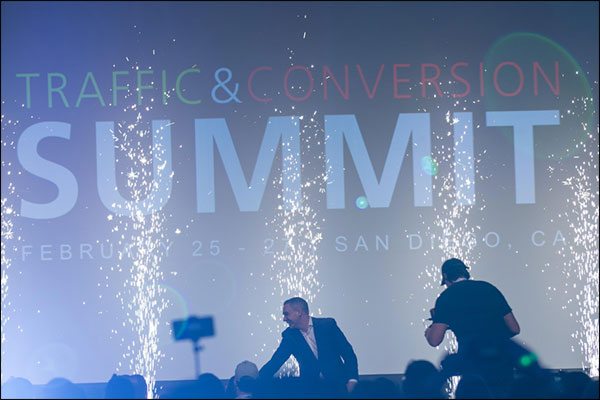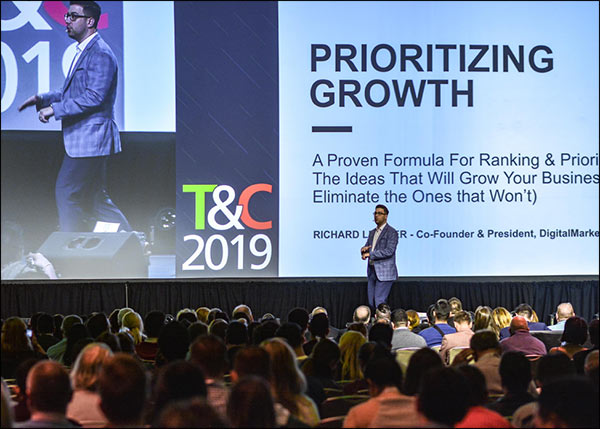It’s been over a month since you left the sunshine of San Diego and headed back to your business, your head and notebooks brimming with new ideas.
Maybe you came back, hit the ground running, did a presentation on everything you learned, implemented every idea you wrote down…
Or maybe—if you are like the rest of us—your next few weeks looked a little something like this…
At first, there was (possibly) the jet lag. And as fun as those 3 days were, you were exhausted from all the travel and all the learning.
So. Much. Learning.
And then, you were busy telling all the fun stories to your coworkers and employees. After all, you got to hear from industry experts and mingle with some of the best up-and-coming minds in marketing… NBD.
And then you may have gotten stuck playing catch-up. You were out for most of the week, and you play a pretty integral part in your business (whether you are running it or not) and you have to make up for all that time.
And we all know that catch-up takes way longer than expected, so once you are finally feeling back to normal, it’s the end of March.
And now, as April begins and you are starting to ramp up into Q2, you may find yourself right back where you were in early February: looking for strategies and tactics to help your business.
But guess what? You already have them.
This post is meant to help you get back on track and actually USE all the information from T&C 2019, because it was good information (in our humble opinion).
Step 1: Go Through and Organize Your Notes
You took in A LOT of info while at T&C. Like info overload.
It’s overwhelming to say the least.
You took in A LOT of info while at T&C.
But remember those notebooks you brought and filled up? The Word doc or notes App on your phone you always had pulled up during sessions? The notes hastily scribbled on the backs of promo fliers or cocktail napkins?
You (hopefully) didn’t just toss them like school notes at the end of the year. Because unlike high school geometry, you actually WILL be using all that info in the real world.
All those actionable strategies will help you move the needle for your business.
You just have to go back and review them.
Now that you’ve had time to process and get back into the swing of things, it’s time to go back with fresh eyes.
What did you jot down from that session in Day 2 that made you excited? What was that lightbulb-over-your-head moment from Day 3?
(NOTE: If you can’t remember or (like some of us) have trouble reading your own chicken scratch, you can use our notes, which have been carefully crafted to include the main ideas from every session at T&C.)
Review and organize your notes. Throw out (or maybe frame) those odd doodles, put the business cards in one pile, put all the tools and products in one pile and the strategies in another.
That way, all the information feels less like an overwhelming mess, and more like the ticket to your business’ success. And then you can actually take action to help your business grow.
Step 2: Reach Out to All Those Contacts You Made
Did you meet someone at T&C you’d like to build a relationship with? Maybe it’s a business partnership, or a potential client, or possibly a new bff!

But it’s never going to happen if you make the #1 mistake about attending a conference—not following up.
Most people return to their offices and never again engage with the people they just met.
In order to build a relationship with a new contact, you need to reach out and start building trust with that person.
But that can be hard. And intimidating. Plus, you’re busy.
So where do you start?
In order to build a relationship with a new contact, you need to reach out and start building trust with that person.
Continue the conversation with these 6 tips for following up:
1. Separate the business cards into different groups. Only save the cards of the people you want to connect with and discard the rest. Then rank the people in the order you want to reach out to them.
TIP: You shouldn’t hold on to business cards and contact info forever. The next best time to throw out business cards is a year from the date you received them if you made no contact with the person in that time.
2. Add all the contacts into your phone or a spreadsheet and include when and where you met the person.
3. You may also want to add something about the person that makes them stand out. This will help to jog your memory when you reach out to them. It will also help you to personalize your message: “We met at Traffic & Conversion Summit. Really enjoyed your thoughts on Day 2’s opening keynote.”
4. Give special attention to the people who asked you to contact them. Reach out to them first, and the sooner the better.
And you should think about emailing, calling, or texting them if you feel comfortable with that and think they would respond positively. Connecting on LinkedIn is great, but not everyone checks LinkedIn every day. On the other hand, most people check their email/phone daily. Like several times a day. An email or a text increases your chances of getting a response.
5. Put thought into your subject line—add in that personalization to help you stand out or catch their eye.
6. And remember, the best time to email is early morning from 6–7am, or around 8pm–midnight, when they’re less likely to be distracted by their busy work day and have time to actually read your email and respond.
By actually reaching out to all those contacts sooner rather than later, you make sure that you aren’t missing out on a connection that could really help your business.
Step 3: Choose Your One Thing
Thinking, processing, and finding inspiration is an important part of the process. But if you want to turn those thoughts into a reality, you gotta take action. Which brings us to our next step… probably the hardest and most crucial one.
You’ve organized your notes, you’ve reached out to your contacts, and you are probably starting to feel that T&C excitement creep back, even without the loud music and flashing lights of the big ballroom. It’s an awesome, exhilarating feeling.

But what you don’t want to happen is let the days start to pass with that list still sitting untouched on your desk. Because days become weeks. Weeks become months… you see where I’m going with this.
And soon you’ll be asking yourself… Have you taken action on any of those great ideas?
In order to prevent this, you need to rank all of those ideas you rediscovered in Step 2 in order of importance. And then, you need to put aside all the rest and only DO ONE THING.
Yep, that’s right. Just one. That’s why we said it would be hard.
We know… All of the ideas on your list are important and exciting, especially when every problem in your business feels pressing.
But if you try to do too many of them at once, 1 of 2 things will happen:
- You won’t know which idea to start on first, so you won’t start any of them
- You’ll start a ton of ideas, but you’ll end up spinning your wheels and having a hard time completing them
If you were around for Richard Lindner’s closing keynote (or if you’ve purchased your handy dandy T&C Notes) you know that he broke down the 4 growth levers for categorizing new ideas: Acquisition, Activation, Monetization, and Retention.

From there, there’s a series of questions you can ask yourself to brainstorm and determine which ideas are most important for your business.
But most importantly, you’ll need a ranking system—one that helps you rank the impact, confidence, and ease a project will have on a scale of 1–10.
Pick ONE thing, and I mean just one, and focus solely on that.
So, make a list of those strategies from your notes that fit your current business needs.
Because odds are, not all of them apply to your business (or maybe don’t apply to your business right now).
Write them down in a separate document from your notes. This way, you can organize your ideas in one spot, and you can brainstorm and flesh out the ideas without getting distracted.
Start with the idea that has the highest total number and then work your way through or eliminate the projects that aren’t feasible.
Then pick ONE thing, and I mean just one, and focus solely on that. This way, you’ll be able to devote all your resources to building and completing your idea.
Okay, so now your focus is on one thing at a time. You’re done… right? Not quite.
Step 4: Make a List of Actionable Steps
During T&C and while reviewing your notes, you probably had several aha moments. But while aha moments work really well as inspiration, they only result in actual change if you break them down into actionable steps.
Once you get your one thing picked out, you want to make sure that you know what to actually do in order to get it done.
For each of your ideas, write down the next 3–5 steps you’d need to take to get this idea off the ground.

And remember, these should be actionable and specific to your business.
But once you have your page—or several pages—of steps, don’t sit back and relax. You aren’t done yet…
Step 5: Implement Your Plan
Now that you’ve got a plan, and you know what it will take to make this one change in your business, it’s time to do it.
You’ve broken it down into steps so that it won’t feel insurmountable. But it will still take time, energy, and focus to make sure that it doesn’t wind up at the bottom of the pile every week.
So set aside a half hour at least twice a week (but every day if possible) to work on your one thing. If you work best in the morning, do this first thing when you get in. Or maybe you can’t go on lunch until your half hour is done.
It can sometimes be hard to implement long-term strategies when the short-term, every-day work feels so much more pressing.
Set aside a half hour at least twice a week to work on your one thing.
So if you feel yourself, a few weeks in, losing focus or drive, write what your business will look like when you get this one thing done on a post-it. Then put it somewhere you will see it all the time—the top of your computer screen or on the coffee machine—so that you never lose sight of why you are doing this.
As time goes on, it may be necessary to check in with your strategies. Does it still make sense to focus on the one thing you’ve chosen as time has gone on? Have circumstances in your business changed that make these strategies no longer applicable?
Examine your one thing every so often to make sure that it:
- Is on track
- Still makes sense for your business
If the answer is yes, then just keep doing what you are doing, but look for ways to optimize.
If your one thing no longer applies or needs to be shelved, it’s time to pivot and choose a different one.
The new one thing may be determined by the thing that made you realize your one thing needed to be put on hold, or you could look at the list of strategies you made in Step 3 and pick your next one thing.
Applying these 5 steps to your business will help you organize your thoughts from T&C, and, more importantly, turn your thoughts into actions. Actions that will move the needle in your business.

And remember, change is painful. Helping your business grow will not be easy, and it will not be quick. But by breaking down the process, and making sure you are set up to make 2019 the best year your business has ever seen.
(NOTE: Since you can’t be in multiple places at once, you missed out on more than 80% of the sessions at T&C, and any of them could have contained a strategy to help your business. But don’t worry, you can pick up the T&C notes, which contain notes from every session at T&C.)
The post So You Went to Traffic & Conversion Summit 2019… Now What? (5 Next Steps to Help Implement What You Learned) appeared first on DigitalMarketer.
from So You Went to Traffic & Conversion Summit 2019… Now What? (5 Next Steps to Help Implement What You Learned)




No comments:
Post a Comment